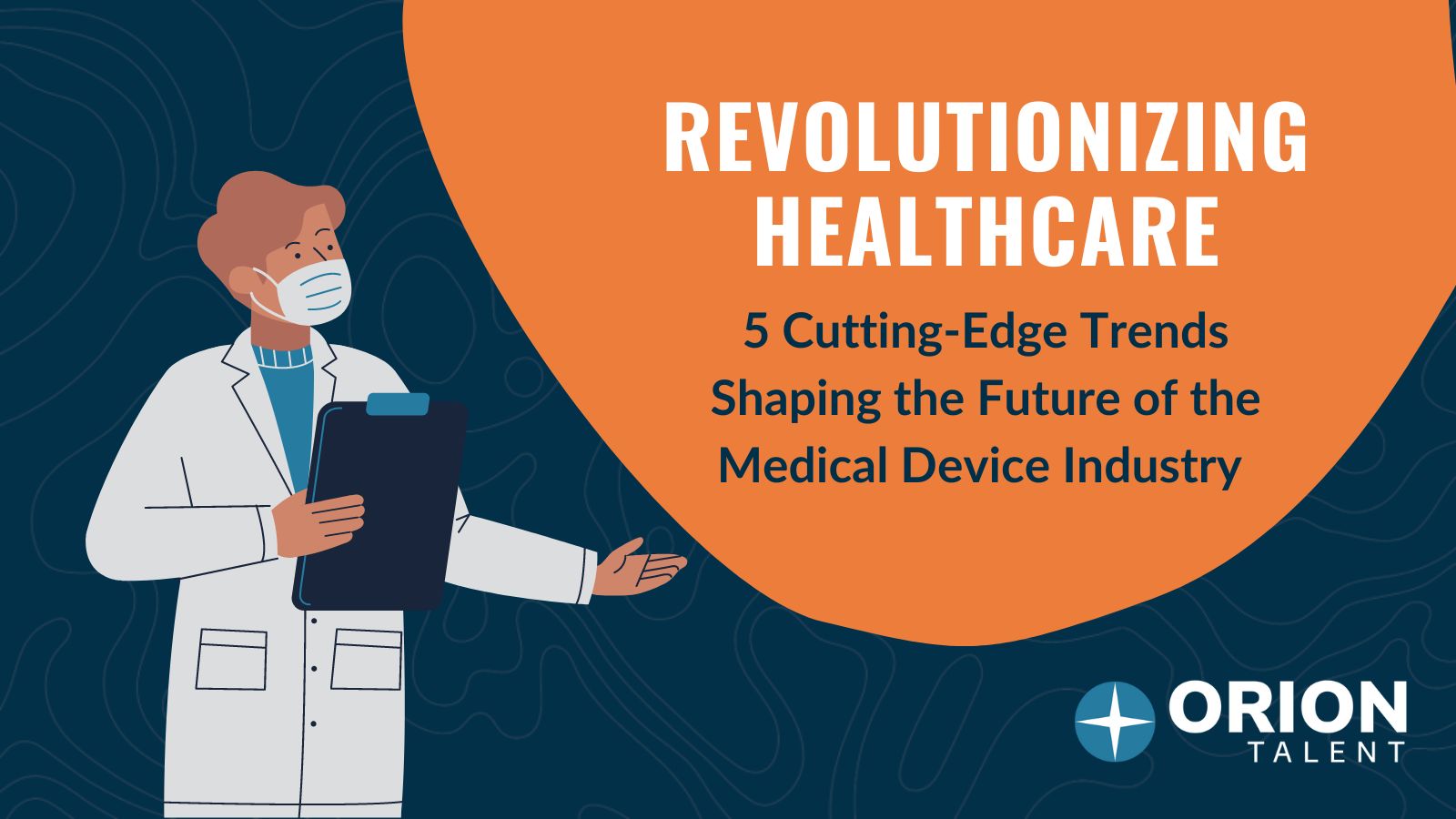
The medical device industry is on a trajectory of steady growth, with an expected annual growth rate of 5.5% to 6.2% through 2030. This above-average industry growth can be attributed to several key factors, including increased investments in Research & Development (R&D), ongoing technological advancements, an aging population, emerging markets, surging demand for innovative therapies, and the rising prevalence of chronic diseases. By 2031, the global medical devices market is anticipated to reach a staggering value of approximately $965.2 billion, compared to $562.6 billion in 2022.
Medical devices encompass a wide range of instruments, machines, implants, and more designed to assist healthcare providers in diagnosing, treating, or preventing diseases and medical conditions. In this blog post, we'll examine 5 cutting-edge trends within the medical device industry that are reshaping healthcare delivery, driving innovation, improving patient outcomes, and transforming the landscape for both manufacturers and healthcare providers.
IoMT and Connected Devices
The Internet of Medical Things (IoMT) market for connected medical devices (wearable, stationary, or implanted) is rapidly growing, expected to reach $94.2 billion by 2026. IoMT is revolutionizing healthcare by connecting medical devices, sensors, and applications to the internet. This transformation empowers healthcare providers with real-time monitoring, data collection, and instant communication with patients. Wearable devices and sensors continuously collect vital health data, enabling healthcare professionals to remotely monitor patients and gain more accurate insights into their health conditions. For example, IoMT facilitates around-the-clock monitoring of patients with chronic conditions, enabling highly customized care. It also supports telemedicine services, enhances medication adherence, empowers individuals with health and wellness apps, aids emergency response, and optimizes supply chain management in healthcare. IoMT has the potential to significantly improve patient outcomes, reduce healthcare costs, and increase access to healthcare services.
is rapidly growing, expected to reach $94.2 billion by 2026. IoMT is revolutionizing healthcare by connecting medical devices, sensors, and applications to the internet. This transformation empowers healthcare providers with real-time monitoring, data collection, and instant communication with patients. Wearable devices and sensors continuously collect vital health data, enabling healthcare professionals to remotely monitor patients and gain more accurate insights into their health conditions. For example, IoMT facilitates around-the-clock monitoring of patients with chronic conditions, enabling highly customized care. It also supports telemedicine services, enhances medication adherence, empowers individuals with health and wellness apps, aids emergency response, and optimizes supply chain management in healthcare. IoMT has the potential to significantly improve patient outcomes, reduce healthcare costs, and increase access to healthcare services.
Personalized and Customizable Solutions
Medical device companies are leveraging technologies like 3D printing to revolutionize the creation of personalized medical devices tailored to individual patient needs. With 3D printing, intricate and customized implants, prosthetics, and orthopedic devices can be fabricated to precisely match each patient's unique anatomical requirements. This approach not only enhances the fit and function of these devices but also expedites production and reduces costs. Another noteworthy trend involves the use of advanced materials with biocompatible properties to develop implants that seamlessly integrate with the patient's body, minimizing the risk of rejection and promoting superior long-term outcomes. This convergence of technology and healthcare is elevating patient care, expediting recoveries, and reducing complications, marking a significant leap toward personalized and highly effective medical solutions.
AI and Machine Learning in Diagnostics
Artificial intelligence (AI) and machine learning (ML) are playing pivotal roles in modern medical devices, particularly by augmenting diagnostic accuracy, forecasting diseases, and advancing decision-making capabilities. These technologies excel at analyzing vast volumes of medical data, including images, patient records, and genomic information, with unprecedented speed and precision. They excel in recognizing patterns and anomalies, which is invaluable for early disease detection and recommending tailored treatment plans. For example, AI-powered medical imaging systems can detect subtle abnormalities in radiological scans, while predictive algorithms can anticipate patient risk factors for conditions like heart disease or cancer. Furthermore, AI and ML enable real-time data analysis, empowering healthcare providers to make more informed and timely decisions, ultimately enhancing patient outcomes and the overall efficiency of medical care delivery.
Telehealth Integration
 Medical devices are increasingly being integrated with telehealth platforms, fostering a seamless amalgamation of remote patient monitoring and virtual consultations. This integration presents a myriad of benefits for both patients and healthcare providers. Patients enjoy the convenience of real-time monitoring of vital signs and chronic conditions from the comfort of their homes, courtesy of wearable devices and sensors. They can also access healthcare professionals for virtual consultations, eliminating the need for travel and reducing wait times. Healthcare providers, on the other hand, are bestowed with a treasure trove of patient data, facilitating proactive interventions and personalized treatment plans. Furthermore, telehealth integration extends healthcare's reach to underserved areas, bolsters continuity of care, diminishes hospital readmissions, and optimizes resource allocation. This seamless fusion empowers patients with greater control over their health while enabling healthcare providers to deliver more accessible and efficient care.
Medical devices are increasingly being integrated with telehealth platforms, fostering a seamless amalgamation of remote patient monitoring and virtual consultations. This integration presents a myriad of benefits for both patients and healthcare providers. Patients enjoy the convenience of real-time monitoring of vital signs and chronic conditions from the comfort of their homes, courtesy of wearable devices and sensors. They can also access healthcare professionals for virtual consultations, eliminating the need for travel and reducing wait times. Healthcare providers, on the other hand, are bestowed with a treasure trove of patient data, facilitating proactive interventions and personalized treatment plans. Furthermore, telehealth integration extends healthcare's reach to underserved areas, bolsters continuity of care, diminishes hospital readmissions, and optimizes resource allocation. This seamless fusion empowers patients with greater control over their health while enabling healthcare providers to deliver more accessible and efficient care.
Minimally Invasive Technologies
Advancements in minimally invasive medical devices, including robotic-assisted surgery tools and microsensors, are reshaping healthcare by drastically reducing patient discomfort, shortening recovery times, and elevating surgical precision. Robotic-assisted surgery systems equip surgeons with enhanced dexterity and precision, enabling smaller incisions and less trauma to surrounding tissues. Consequently, this minimizes post-operative pain and expedites patient recovery. Moreover, microsensors offer real-time feedback during surgeries, enabling surgeons to make precise, well-informed decisions and mitigate potential complications. Collectively, these innovations are not only making surgical procedures less invasive but also elevating patient outcomes and quality of life, ushering in a new era of minimally invasive medical procedures.
Medical Device Hiring Trends
The outlook for hiring in the medical device industry remains robust as it continues to adapt to evolving healthcare needs and technological advancements. The industry's sustained growth is driven by factors such as an aging population, growing demand for innovative medical technologies, and an unwavering focus on improving patient outcomes. Consequently, there's an enduring demand for skilled professionals across various domains within the industry, including research and development, regulatory affairs, engineering, quality control, and sales and marketing.
If you’re looking to fill open roles within the medical device industry, Orion Talent’s talent solutions can help you meet your goals. We’ve placed more than 6,000 Junior Military Officers and Military Technicians into various roles within the Medical Device and Medical Manufacturing industries. Contact us to learn how our candidates can make a difference within your organization.
Archives
- July 2025
- June 2025
- May 2025
- April 2025
- March 2025
- February 2025
- October 2024
- May 2024
- March 2024
- February 2024
- January 2024
- December 2023
- November 2023
- October 2023
- September 2023
- August 2023
- July 2023
- June 2023
- May 2023
- April 2023
- March 2023
- February 2023
- January 2023
- December 2022
- November 2022
- October 2022
- September 2022
- August 2022
- July 2022
- June 2022
- May 2022
- April 2022
- March 2022
- February 2022
- January 2022
- December 2021
- November 2021
- October 2021
- September 2021
- August 2021
- July 2021
- June 2021
- May 2021
- April 2021
- March 2021
- February 2021
- January 2021
- December 2020
- November 2020
- October 2020
- September 2020
- August 2020
- July 2020
- June 2020
- May 2020
- April 2020
- March 2020
- February 2020
- January 2020
- December 2019
- November 2019
- October 2019
- September 2019
- August 2019
- July 2019
- June 2019
- May 2019
- April 2019
- March 2019
- February 2019
- January 2019
- December 2018
- November 2018
- October 2018
- September 2018
- August 2018
- July 2018
- June 2018
- May 2018
- April 2018
- March 2018
- February 2018
- January 2018
- December 2017
- November 2017
- October 2017
- September 2017
- August 2017
- July 2017
- June 2017
- May 2017
- March 2017
- February 2017
- January 2017
 RSS Feed
RSS Feed
Subscribe to Orion's Blog
Featured Blogs





.jpg)














